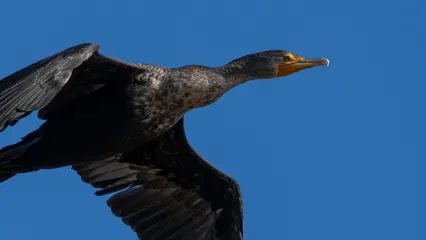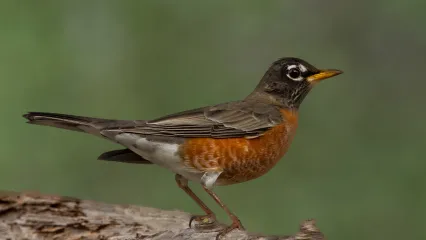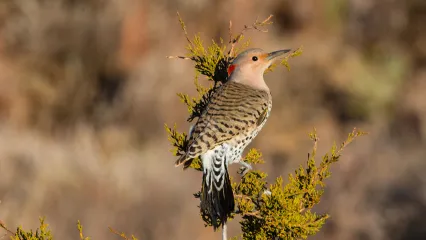
Description
When it comes to fishing technology, few anglers can compete with the advanced skills of the double-crested cormorant. The double-crested cormorant (Phalacrocorax auritus) is a goose-sized bird with a yellow throat patch highlighting a black iridescent green or purple body. It has bright turquoise eyes, webbed feet and a long black, hook-tipped, slender bill. In the spring, adult cormorants have two small tufts of feathers on either side of their head, a trait that gives the species its name.
For a species that was nearly placed on the endangered species list in the 1960's, the double crested cormorant, often called the water turkey, has made an incredible recovery. This fish-eating bird suffered a near demise earlier in the century due to the use of DDT which thinned the birds' egg shells, causing them to break under the weight of the incubating parent. Since the banning of DDT and through continued protection under the Migratory Bird Treaty Act of 1918, populations have increased to around two million birds, leading anglers and aquaculturists to ask the U.S. Fish and Wildlife Service to devise a plan for curbing cormorant numbers.
Cormorants are water-loving birds that choose nesting and roosting habitats safe from ground predators but close to feeding areas. When on the water, they are sometimes mistaken for geese and loons because of their longs necks, head and bill. Cormorants fly in the shape of a 'V" just like geese, but often glide while flying which is uncharacteristic of geese. Cormorants are rarely vocal when flying.
Double-crested cormorants are opportunistic fish-eating birds preying on a variety of fish, but concentrating on those that are easiest to catch. Their webbed feet, positioned far back on their bodies, propel their stream-lined frames to depths of 20 feet or more in search of prey They can remain underwater for about 30 seconds. On average, double-crested cormorants forage 60 minutes per day and consume one pound of food.
Although expert swimmers and divers, cormorants look like they struggle to stay afloat. They are commonly seen with only their heads and necks exposed from the water. Cormorants lack the oil glands that other water birds have so their feathers don't repel water well. They perch on rocks or in trees with their wings half open to dry in the sun. To take off from water, cormorants gain speed by tiptoeing along the surface while flapping their wings. Upwards of 50,000 double crested cormorants winter in Oklahoma every year.
Size
They grow as big as 28-35 inches long with a wingspan of 45-48 inches.
Habitat
Oklahoma's numerous reservoirs and abundant fish populations are an eye-opening treat to upwards of 50,000 cormorants migrating to and from breeding grounds during spring and fall. The large numbers of double crested cormorants may not be welcomed with opened arms, but they stand as a testament of how successful conservation efforts can be.
Cormorants almost always nest in colonies, which may comprise more than a thousand breeding pairs. They build their nests of sticks and coarse vegetation on cliff ledges, in trees in or near water, or on the ground. No nesting colonies have been found in Oklahoma, but the primary breeding ground is in the northern United States and Canada.
Life Cycle
Female double-crested cormorants begin breeding at age three or four and usually only have one brood per year. They lay three to five chalky pale blue eggs in April that hatch after 25-28 days of incubation. At seven weeks, the young are able to join the adults to feed and at ten weeks the young are fully independent.


